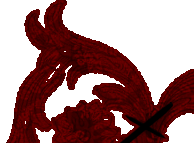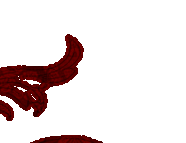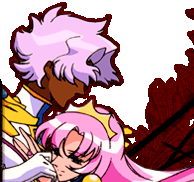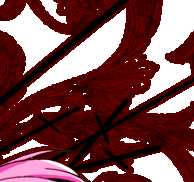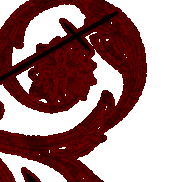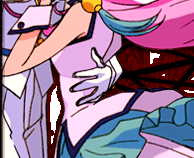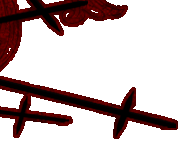
This analysis
was donated by Clarice. Page 1 +++ Page 2
 The Love Song Of J. Alfred Prufrock:
Who was Professor Nemuro?
'I should have been a pair of ragged claws
Scuttling across the floors of silent seas.'
The tragedy of Professor Nemuro can be likened somewhat to the “journey” of the narrator in T. S. Eliot’s poem “The Waste Land.” Take for example the beginning of the poem; it has an extract in Latin and Greek which translates to I have seen with my own eyes the Sibyl hanging in the jar, and when the boys asked her “What do you want?” she replied “I want to die.” These are the words of one trapped in life and unable to die; this is what Mikage is. An imaginary living body, Professor Nemuro is Souji Mikage and is unable to die…until he becomes one of the few graduates of Ohtori Academy and leaves the garden where no child can ever become an adult.
Professor Nemuro was a genius – a young genius, as befits the nature of Ohtori Academy. It is not a place for “adults;” indeed, it seems that Akio Ohtori works his best manipulations through the minds and dreams of children, of young people. Nemuro enters the Academy as a disinterested scholar, a genius that can’t be tied down to earth – and this genius is eventually trapped in the Academy when memory and desire are twisted and tangled, creating for him his own coffin below the depths of “Nemuro Memorial Hall.”
Souji Mikage is another version of Nemuro, or so it appears. It is unclear to us exactly what happened to Professor Nemuro after the fire at the Hall where he worked, but it is clear that Mikage and Nemuro were once the same person. Mikage does not revert back to being Nemuro until his memories are truly “quickened.” However, while Mikage has been existing merely through the power of memory, the memories he has are not real. They are what Akio has given to him.
But what were the memories that Mikage cherished so much, the memories of Professor Nemuro that Akio Ohtori exploited so callously? They are the key to Mikage’s very existence, the Hell that is his past remembered happiness. Akio uses the memories he twists to make the hourglass run slow – and he shows Mikage, the “honourable shadow” of Professor Nemuro, fear in a handful of dust.
 The Burial Of The Dead:
Black Rose Symbolism
'I was neither living nor dead, and I knew nothing.' Some of the key symbolism of the Black Rose Arc is found principally in the two episodes that deal with the past of the non-existent building, Nemuro Memorial Hall, its non-existent master, Souji Mikage, and its non-existent resident, Mamiya Chida. The symbols that surround Professor Nemuro and Souji Mikage in episodes 22 and 23 are perhaps the most penetrating – as they relate directly to the memories of Professor Nemuro and shaped the man Souji Mikage would become – and it is to these we must look for insight into who the “imaginary living being” truly was.
The first thing that one might notice is the allusions to Professor Nemuro’s existence as “a computer-like man,” as he is nick-named by the students he supervises. Upon entering the school, Professor Nemuro begins to notice things that he has never noticed before. We are shown this by the way a hand appears, similar to a cursor of a mouse, accompanied by a computer-like beeping (notice this hand is the same hand that directs people to the Mikage Seminar…every student comes to the seminar only when their eyes have been opened to something they themselves never really saw before). This happens with a number of things as they catch Professor Nemuro’s attention. Each symbol is apparently communicating to us something significant. We are shown: a cat in the window, a teapot, a butterfly, another cat, again a cat, two students holding hands, lipstick, Mamiya and Tokiko, the lipstick again, and finally Tokiko and Akio. Each is a symbol associated with either affection, friendship, rebirth and regeneration, or love. These are three things Nemuro has never known until now; the computer-like man doesn’t understand the workings of the heart…until he is drawn into the world of Akio Ohtori.
 The Symbols That Open The Professor's Eyes Treating each symbol in turn, we firstly look at the three cats, who appear one after the other in Tokiko’s window as she speaks to Nemuro about the research going on at the school. They appear to be symbolising a family, which becomes very important in determining the relationship between Mamiya and Mikage as opposed to the relationship between Professor Nemuro and the boy. There are two larger cats, and one smaller cat. They are a family: Nemuro, Tokiko and Mamiya. Of course, one can also take them as the classical symbol of bad luck, and they do say bad luck always comes in threes…and Professor Nemuro certainly gets his fair share of bad luck in Akio’s Academy.
The teapot is merely symbolising affection; making tea for another person is a gesture of friendship, something it may be fair to say Nemuro doesn’t get a lot of. He reacts to the student on the staircase earlier in the episode almost rudely when asked about the snow, and is never terribly warm towards the student in the spontaneous, “break the ice” conversation. The student later remarks to his colleagues “The man himself is quite dry” and implies that Nemuro is simply a person who doesn’t care. Nemuro even makes a point of asking Tokiko at the outset of their meeting in her house over the tea, “You’ve called me all the way out to your house, so what do you want?” apparently showing that he isn’t terribly used to the idea of friendship for friendship’s sake.
The butterfly is a symbol that has its roots in earlier episodes of this Saga, and is deeply associated with the leaf symbol in these two episodes and Mikage’s elevator. In Mikage’s elevator, as a student descends to their “heart of darkness” we are shown several things on the specimen box on the elevator wall. It begins as a butterfly, moves through to a chrysalis, to a caterpillar, to a leaf (perhaps with eggs on it). This is an indication of a journey; the person is reverting to a state in which they can be reborn, which obviously happens with each of the Black Rose Duellists. They are reborn – a green leaf symbolises springtime, the period of Easter, of death and rebirth – as different people are forced to duel Utena Tenjou for the Rose Bride. Nemuro’s first transition is not so outwardly sinister, though it becomes obvious later that Nemuro’s change is possibly not for the better in the end. However, Nemuro is indeed “reborn,” coming to life as it were. The mechanical man takes on a new vitality; his students notice that he is excited and enthusiastic about the research now. Nemuro is a changed man, having seen for the first time the way to love somebody.
As he is talking to Tokiko, Nemuro receives something of a flashback to some of the hundred youths ascending the staircase to the Hall. He noticed that two of the young men are holding hands. This could be taken either as simple friendship or something deeper, but its impact on Nemuro is the same. It is a sign of affection, of love, be it platonic or romantic. In fact, the ambiguity is in fact possibly intentional, for the two loves Nemuro discovers he can feel are both. He is romantically in love with Tokiko and platonically in love with her brother.
The lipstick on the teacup is related to two things in the context of these two episodes; the first is that it is a symbol of the friendship Tokiko and Nemuro are building up “over the teacups.” It reoccurs slightly differently later in the episode when it is seen again, when it is to do with the contract Nemuro is asked to enter into and the nature of what he must do to fulfil his duties.
The next – major – thing shown to us and Nemuro by the cursor-hand is Tokiko and Mamiya themselves, and the relationship between the pair. It seems safe to assume that the pair’s parents are dead or absent, leaving Tokiko alone to bring up her younger, ailing brother. Nemuro is astonished by the passion of Tokiko as she tells her brother “What I hate the most is someone who doesn't look after themselves!” The importance of this devotion is what obviously strikes a chord with Nemuro, because when Mikage overhears Utena Tenjou use a similar phrase to Anthy Himemiya, the automatic association he makes is to Tokiko. It is this relationship between sister and brother – and Tokiko’s later tears over the matter, the “first” time Nemuro had seen someone cry – which opens his eyes to love and what he feels can be his family.
The last symbol is perhaps the disturbing shattering of the illusions Nemuro has been building from these symbols. When Nemuro chases the coffin the evening Akio gives him the Rose Signet – passing by a black rose on the journey – he comes across a scene that breaks him.
It is Akio and Tokiko caught in a passionate embrace.
This is where the lines between Nemuro and Mikage become indistinct; this is the key turning point, the true rebirth of Nemuro himself as Souji Mikage, the principal Black Rose Duellist. But this is tied up with the fire that ultimately destroyed the building where the research took place, one of the most tangled memories of the Professor and the key to understanding Mikage. However, before the fire is explained, there are numerous other symbols to be taken into account.
 The Contract and the Rose Signet The Rose Signet is placed in the cup Tokiko has been drinking out of, and indeed, Nemuro’s acceptance of the contract seems partly based on his desire to please the woman to make her love him…but the Rose Signet itself, worn by all the hundred boys and now potentially by Nemuro, is a very important symbol in itself. It is a contract, emphasising Nemuro’s earlier statement that he is involved in the research “Purely for business reasons.” In fact, this is one of the indications that this is how Nemuro brought himself to burn the building down in the first place. There are three things that let his conscience rest somewhat, become lax enough to light the fire. The first is that it would allow him to grasp eternity, thereby releasing Mamiya from his illness and making Tokiko happy. However, he states that “…even if I do grasp eternity by doing this, she won't be very happy.” He is in fact further compelled to do so by Mamiya’s peculiar change of heart. While Mamiya has previously insinuated that he did not want to live forever, Mamiya later comes to Nemuro – caught in the web of his indecision over whether or not to undertake the “required sacrifice” – and insists he wants eternity after all.
The third thing is the simple matter of the contract – the boys are being treated as “spare parts, so to speak.” Akio insists they have a contract; Nemuro later uses this as his excuse to Tokiko as to why he did what he did. “Those boys had a contract.” He also seems to justify it to himself with a scientist’s detachment – “Those boys had a contract. Ancient creatures died and left naught but fossil fuels, like coal and petroleum. Without that sacrifice, our present energy civilisation would not exist. That sort of sacrifice is what is always demanded.” Whatever Nemuro’s true feelings were, when he put on the Rose Signet, he become a tool of the Ends of the World. He himself had a contract with Akio – and even though Mikage later insists “I've done nothing more than make a deal with you. There's no reason for me to obey your orders,” it becomes clear to us that he is compelled to continue the grasp for eternity…for the ward so constantly at his side.
 Time And Photographs The hourglass is an important symbol in this arc because of the ambiguity of time in this world. It is never entirely clear how much time passed between the fire at the Hall and the present of the series, though we are given indications, the key one being Tokiko’s apparent age when she returns to the Academy. The passing of time is also indicated by numerous other things – the pictures are one example. In the past, there is a picture of Tokiko and Mamiya that is later displayed in the montage in Nemuro Memorial Hall. However, it is no longer in colour – it is in black and white, seeming to indicate that it is in the past, lost like the sands that slip so reluctantly through the hourglass.
Of course, the pictures themselves are symbolic of several things. They are symbols of the past; perhaps they are also Mikage’s way of clinging to the memories of Professor Nemuro, no matter how inaccurate they can and do become. There is a picture of Mamiya on the desk Mikage sits at, forever keeping his goal in front of him – as a scientist, Mikage needs something to work for. The pictures on the wall are also symbolic of the past and rebirth. Utena, Nemuro, Tokiko, Mamiya, Kanae, Kozue, Shiori, Tsuwabuki, Wakaba, Keiko…the Black Rose Duellists have their rebirth as those bitter individuals forced to duel with Utena in the sky. Tokiko is “reborn” through Mikage’s misconception that the woman is working through Utena to destroy him. Mamiya is reborn through the false Mamiya, the mask behind which Anthy hides. Utena has been reborn from the girl hiding in the coffin to the girl who wishes to become a Prince. Nemuro has been reborn as Mikage, his purpose being to grasp eternity for Mamiya. The pictures are the past that drives them forward.
However, the hourglass is a symbol of how time is manipulated by Akio. “I exploited the illusion you cherished in your memory so much that you even halted your own time.” When Tokiko returns to the Academy, it is obvious to her that the time is skewered…something that she noticed earlier when she was making Professor Nemuro tea. “I wonder if even an hourglass can run slow,” she says in confusion, though when she returns so many years later, the strangeness of time does not appear to bother her so any longer…she merely states “there’s something wrong with that, though,” when Akio says that no child becomes an adult in the Academy. There are two hourglasses associated with Mikage and Professor Nemuro – Tokiko’s, and Akio’s. Tokiko’s merely seems a symbol of how a “normal” person in the Academy could notice the oddness of time – perhaps Miki Kaoru is the only other person likely to notice this, what with his stopwatch fetish – while Akio’s is a symbol of how he is in fact controlling Mikage and manipulating his memories so that his time is in fact halted.
Time and eternity – nothing and all – are very important ideas in this arc, naturally. Nemuro’s first thoughts on this subject are obvious; he makes a clear indication that the thought of building a perpetual motion machine is silly, as well as being impossible. He thinks mechanically, does this computer like man, and his machine-like brain cannot grasp the concept of something so utterly metaphysical. It is not until his mind is opened to the emotional world of love and affection that he realises that it is a worthy dream. This is echoed by the fact that he reaches a stalemate later on in his zealous mission to grasp eternity – he can’t solve the final equations, the last analysis. He needed to do it another way, a way not so mathematical, not so reasonable; and it was perhaps it was his realisation of this that made him more open to Akio’s highly irrational plan to sacrifice a hundred youths to open the road to eternity from the Academy.
 The Tears There is also a little to do with tears as symbols. Water falls into the black rose aquarium, to touch upon the roses, the water. This is perhaps more a symbol of opening gates – they resemble the water droplets that open the waterlock of the gate leading to the Duel Arena, and later Utena’s own tears, which open the Rose Gate that seals away the Power of Dios – but they could perhaps be the tears of Mamiya. He does, after all, sometimes allude to an abhorrence of what he and Mikage are doing, much as the true Mamiya once expressed a dislike for the thought of making something last forever even when it perhaps really wanted to die. At one point, Mamiya does call Mikage “A wicked man.” More tears seen in association with Nemuro are the tears of Tokiko, the ones she sheds when detailing her brother’s tragedy. When she apologises for crying in front of him, Nemuro makes a strange response for the uncaring computer-like man: “It’s all right. It feels like this is the first time I’ve ever seen a person’s tears.” Nemuro is alluding to the fact that real tears are a symbol of true emotions that he has not understood until introduced to Tokiko; it is a part of his awakening or rebirth.
Finally, Mikage’s tears symbolise his emotions. He weeps in the elevator he is at last ironically taking down himself; the supposed puppet master has fallen so low that he is subjected to his own psychological analysis. He seems fascinated by his own tear, as if he didn’t think he could cry. It is a part of Nemuro displayed prominently in Mikage; the computer-like man can be broken. C-ko’s statement that “…a robot does not worry…a robot is not lonely,” seems to be untrue. Mikage is falling ever deeper into the realm of strong emotion…the realm that kept this imaginary living being as a prisoner of the Academy for so very long.
 Mamiya and His Roses Mamiya Chida is a very intriguing character. Long before he was to be made in the Rose Bride, he had an interest in roses…he tended to them as Anthy Himemiya herself does. In fact, even though he is dying and knows he should be in bed, his main concern is the roses in the greenhouse. Consequently, his roses come to be descriptive of his very character and who is precisely.
The key symbol his roses represent are the fragile nature of life itself. Cut flowers, of course, will not live long…but even the flowers on the bushes still will not last forever. Mamiya alludes to the fact that he himself is a rose…he implies his sister makes rose sugar pickles and dry flowers because “She doesn’t want to see the flowers scatter, you see.” Tokiko is of course trying to do the same for Mamiya, to make him last forever…but what does Mamiya have to say on the matter?
“But, I wonder if the flowers themselves are happy, being forced to last so long.”
Nemuro is apparently insulted by this remark, thinking Mamiya is ungrateful of what Tokiko and the Professor are trying to do for him. Mamiya insinuates that it isn’t so, but he also seems to warn Nemuro under the statement “Eternity doesn’t exist in this world, does it? It’s just that one could think that a heart that longs for eternity is beautiful.” It seems to be a subtle warning on the boy’s part that eternity is not what it seems…and indeed, if Mamiya was made eternal by becoming the Rose Bride, his fate would not be entirely pleasant.
Mamiya’s roses are the symbol of the price of eternity…and the indication that Mamiya is perhaps the only one of the three who does not want the eternity they struggle for. Does Mamiya want to die? Does Nemuro realise this? Certainly, he later seems reluctant to do anything drastic about grasping eternity after speaking to Mamiya…but when Mamiya has a change of heart, the Professor seems ready again to strive towards such things…
However, Mamiya’s roses also lead into another symbol…the peculiar reference to a controversial work of art.
 Olympia One scene in the episode ‘Qualifications of a Duellist’ is perhaps very unusual in the manner it alludes to two famous paintings. It is most closely associated with Manet’s Olympia, which is in turn a nineteenth century pre-Impressionist work based on Titian’s sixteenth century work Venus of Urbino. That in itself is perhaps an indication of why it is there; there are two versions of the painting, and there are two versions of the man principally in the “painting” as shown in the anime. There is Professor Nemuro, and then there is Souji Mikage.
The figure prominent in Olympia is very different to the prominent figure in Venus. While the latter is a goddess, the former is a courtesan. In fact, Olympia was widely condemned by critics of the time for precisely that reason – it was not customary to paint such woman in such a manner. The way the painting was executed is also in a manner the critics called “childish” with obvious strokes and a very realistic “warts and all” impression. In fact, it has been said of the painting: “Instead of the carefully constructed perspective that leads the eye deep into the space of the painting, Manet offers a picture frame flattened into two planes. The foreground is the glowing white body of Olympia on the bed; the background is darkness.” This is reminiscent of Mikage; a two-dimensional “shadow” surrounded by darkness.
Of course, the most interesting thing is the composition of the painting. Why is Mikage/Nemuro represented as a courtesan? Why does Mamiya offer him roses? Why is the cat in Manet’s picture missing? All are very symbolic answers. In Manet’s painting, there is a black cat; this cat is missing from the scene depicted in the anime. Think back to the earlier symbols of the cats; they represent a family. In this scene, Nemuro has realised that he can not create a “family” situation – like the cats in the window – with Tokiko and Mamiya because Tokiko is involved with Akio. And so, the black cat – an implication of Tokiko’s presence – is noticeably missing.
Mamiya is shown in the scene to be presenting Nemuro with a bunch of roses, just as the servant girl does for the courtesan in the painting Olympia. They are said to be in the original painting a gift from a client of the courtesan – and this is a heavy inference that Akio had in fact interfered with Mamiya himself. After all, Mamiya once told Nemuro he didn’t want to go on forever, liked the dried flowers his sister took such pleasure in making. It wasn’t until Akio asked Nemuro to burn the building down that Mamiya apparently changed his mind on the subject. This sudden change of heart – mixed with the implications of the roses Mamiya offers Nemuro – seems to indicate that Akio talked Mamiya into telling Nemuro he wanted to live forever.
And Nemuro/Mikage as the courtesan? The courtesan in the painting is perhaps identifiable with Mikage, while the Venus of Titian’s painting is identifiable with Nemuro. Why is this? Mikage is the “earthy” side of Nemuro, more sensual and more capable of manipulating people to his own ends. And it was “doubly disturbing” of Manet’s painting that the subject had a real identity, just as Mikage himself had a “real” identity – Professor Nemuro. And of course, what is a courtesan? “A woman whose body is a commodity.” Indeed, Mikage, the imaginary living body, is a commodity, a possession Akio does away with when he decides he has no further need of him.
(This particular frame – the one resembling Olympia and Venus of Urbino – is found in episode 23, when Mamiya discusses with Nemuro the nature of eternity.)
 The Snow When we first see Professor Nemuro, he is being questioned on the staircase to the research Hall about the snow. The student asks him “It doesn’t seem to disappear too quickly, does it, Professor Nemuro?” This theme is repeated later with the comment Professor Nemuro makes to Mamiya along the same lines – “The snow in this garden doesn’t disappear so easily, does it?” Both are indicating that the winter is slow and unwilling to leave, which is perhaps an indication that time is running unusually slow in the Academy.
However, this theme could be taken in the context of April, the month of Easter, of green leaves and rebirth. ‘April is the cruellest month, breeding/Lilacs out of the dead land, mixing/Memory and desire, stirring/Dull roots with spring rain./Winter kept us warm, covering/Earth in forgetful snow, feeding/A little life with dried tubers.’ Professor Nemuro is an emotionless creature, buried underground in frozen soil, seeming not to care about the world above him. As time passes at the Academy – no matter how peculiarly – he begins to grow. He is reborn into the world, a man of feeling, emotion, desire. The indication that the “snow doesn’t melt too easily” is perhaps just saying that Nemuro was not easy to turn. However, he does grow up out of the frozen ground. He seems to realise this, because when he says to Mamiya that the snow doesn’t disappear too easily, he sounds vaguely wistful. It is only the reluctance to let go of the past that drives him to say this, perhaps; after all, it is soon indicated to us that Professor Nemuro will cling to his memories at any cost.
The snow is frozen, it melts with only great difficulty – and when we see the snow, when it is mentioned to us, we are being given a metaphor of the Professor himself. For Nemuro, his time under contract to the Academy is a time of transmutation. The frozen man is being melted so very slowly into a new creature who can feel the passionate emotions he once believed could not possibly exist.
 The Butterflies and the Elevator This idea ties in very firmly with the earlier ideas of rebirth and journeys. As was shown in the analysis of the symbols that opened the Professor’s eyes, the specimen box in Mikage’s descending elevator is a repository for several symbols that indicate this journey through an emotional waste land of negative feelings. It is a journey in fact comparable with Conrad’s novella Heart of Darkness; those in the elevator sink deep within their human psyches and find nothing there but murderous hate. This is of course partly Mikage’s fault, but it is also tied up with the popular literary/evolutionary idea that humans are savages at heart. Mikage’s elevator is a portal to the darkness inside…such as Mikage himself is perhaps the darkness inside of Nemuro’s own heart.
Of course, the butterfly is also a symbol of the soul and transcendence; when a person dies, in literature their soul leaving their body can be represented as a butterfly leaving the shackles of the “natural” or the mortal world. By metaphorically “catching” these butterflies of people’s innocence – a child is innocent and more attached to the world of the transcendent than is an adult – Mikage is drawing the innocent down into the darkness. It has a vague overtone of a fall from grace, as is mirrored by the way the elevator descends into darkness. One might also care to remember that Mikage says the room where the elevator ends its descent leads to the Ends of the World…whom we eventually are to discover is Akio Ohtori himself. Keeping in mind that Akio archetypes himself on Lucifer at one point in the story, we have a reflection on another fall – this time from heaven. The elevator truly asks us to “go deeper,” in terms of our souls and our minds.
The negativity of this fall from grace is very real, and it perhaps reflects one of the reasons why Akio had Nemuro burn down the Hall in the first place, when it becomes obvious to that this sacrifice was completely unnecessary. Only those whose memories invoke negative emotions in them can be taken down by Mikage’s elevator. How is this shown to us? By the fact that Tatsuya Kazami had no place in the elevator. His emotions were at their most extreme in his desire to protect Wakaba from her perceived loss of innocence – there was no negativity directed towards the man who would do this to Wakaba. Therefore, Tatsuya could not fall. Nemuro could fall, however – his passion came through most obviously when he fought the duel to defeat Tokiko. If his zeal had been more towards protecting Mamiya, he would have fought his duels himself from the beginning. Only those who have negativity associated with their memories can be asked to fall for their sake – “You sound like you're yelling out, ‘Don’t touch my precious memory!’” Indeed, only those who will go to any cost to protect their memories can be turned to their blacker natures for the sake of Mikage’s desire to save Mamiya.
It is the elevator that allows Mikage to “rebirth” those who enter the ironically named Nemuro Memorial Hall…is this a mirror of how Nemuro himself was apparently reborn twice? Once, the computer-like man became a sentient being…and then the one who loved not wisely but too well left himself wide open for the machinations of the greatest Iago of them all.
Continue to Page 2 of For the Garden Where All Love Ends ->
 |

